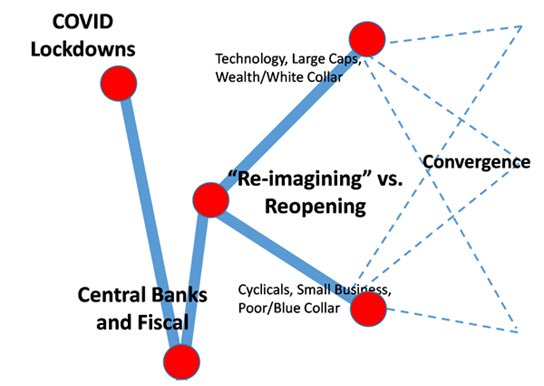K-Shaped Economic Recovery | 18 Jan 2021
Why in News
Recently, the latest readings of the Nomura India Normalization Index (NINI) suggested the impact of Covid-19 on Indian Economy and the K-Shaped Recovery through which the Indian Economy is recovering.
- Nomura Services India Private Limited (Nomura Holdings Inc) is a consumer services company.
Key Points
- Effect of Covid-19 on Households:
- Households at the top of the pyramid are likely to have seen their incomes largely protected, and savings rates forced up during the lockdown, increasing ‘fuel in the tank’ to drive future consumption.
- Households at the bottom are likely to have witnessed permanent hits to jobs and incomes.
- Effect of the Current Monetary Policy:
- A long lasting period of ultra-accommodative monetary policy has led to a fall in real lending rates and spreads for corporates and households that should eventually come as lagged relief to the interest-sensitive sectors.
- An economic spread is a measure of a company's ability to make money on its capital investments.
- Impact of Vaccination:
- Lagging sectors such as travel, tourism and hospitality will finally emerge out of the effect of Covid-19.
- Economic Recovery after Covid-19:
- As the fiscal deficit in FY 2020-21 has widened to roughly 7% of GDP, which is double the pre-pandemic target of 3.5 % of GDP. The government may, therefore, feel encouraged to rely on higher fuel taxes, disinvestment, and sin taxes to bolster coffers.
- India is going through a K-shaped recovery, wherein corporates and households with stronger balance sheets have recovered more robustly, while smaller firms and poorer households probably remain trapped in a vicious cycle of poverty and indebtedness instigated by the pandemic.
Economic Recovery
- About:
- It is the business cycle stage following a recession that is characterized by a sustained period of improving business activity.
- Normally, during an economic recovery, GDP grows, incomes rise, and unemployment falls and as the economy rebounds.
- Types:
- Economic recovery can take many forms, which is depicted using alphabetic notations. For example, a Z-shaped recovery, V-shaped recovery, U-shaped recovery, elongated U-shaped recovery, W-shaped recovery, L-shaped recovery and K-shaped recovery.
- K-Shaped Recovery:
- A K-shaped recovery occurs when, following a recession, different parts of the economy recover at different rates, times, or magnitudes. This is in contrast to an even, uniform recovery across sectors, industries, or groups of people.
- A K-shaped recovery leads to changes in the structure of the economy or the broader society as economic outcomes and relations are fundamentally changed before and after the recession.
- This type of recovery is called K-shaped because the path of different parts of the economy when charted together may diverge, resembling the two arms of the Roman letter "K."
- Implications of a K-Shaped Recovery after Covid:
- Households at the bottom have experienced a permanent loss of income in the forms of jobs and wage cuts, this will be a recurring drag on demand, if the labour market does not heal faster.
- To the extent that Covid has triggered an effective income transfer from the poor to the rich, this will be demand-impeding because the poor have a higher marginal propensity to consume (i.e. they tend to spend-instead of saving) a much higher proportion of their income.
- If Covid-19 reduces competition or increases the inequality of incomes and opportunities, it could impinge on trend growth in developing economies by hurting productivity and tightening political economy constraints.
Way Forward
- Given the K-shaped recovery and the new “pandemic poor”, the budgets for spending heads such as subsidies, employment generation, rural development and other social sector programmes are likely to remain large. The vaccination costs add to the bill. The government will also have to sharpen its focus on capital spending to contain damage to potential growth.

